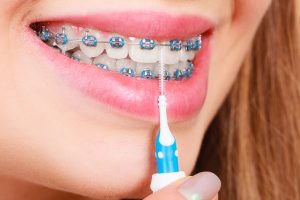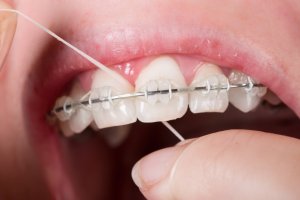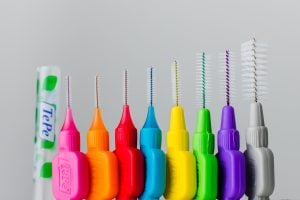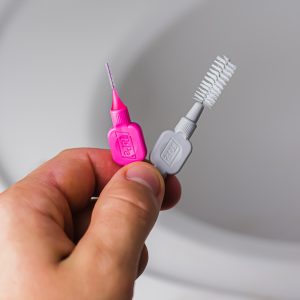Are you wondering how to floss with braces? Cleaning around those wires and brackets can be a pain, but oral hygiene is more important than ever during orthodontic treatment. Braces provide lots of hiding places for bacteria, so you need to do a thorough job of cleaning them.
Fortunately, with the right products and techniques, you can soon master the art of cleaning between your teeth with braces. We're going to look at some products that might help, including:
- Floss threaders
- Orthodontic dental floss for braces
- Interdental brushes
- Water flossers
Keep reading for our tips to make the teeth flossing process that bit easier while you or your child have braces.
Best Products for Easier Flossing with Braces | ||
Oral-B Superfloss   |
| |
GUM Eez-Thru Floss Threaders   |
| |
Waterpik WP-660UK Ultra Professional Water Flosser   |
| |
In This Article
Why is flossing with braces important?
Our teeth are under constant attack from acid and bacteria in the food and drink we consume. Brushing twice a day and flossing daily is usually enough to keep teeth healthy.
However, braces create more surfaces for bacteria to cling to and more holes for food to get stuck in. They also make your normal teeth-cleaning routine more tricky and time-consuming, but if you don't make the extra effort to maintain good oral hygiene, you're at risk of getting:


- Bad breath
- Yellow or stained teeth
- White patches on your teeth
- Tooth decay
- Gum disease
These conditions can also affect the progress and success of your orthodontic treatment to get well-aligned teeth.
The purpose of orthodontic treatment is to get well-aligned teeth for esthetics and effective oral hygiene practice. The treatment can be carried out with a wide range of materials and techniques but usually fall under metallic or ceramic braces.
So, what happens after you get stuck with braces on your teeth and are undergoing treatment?
During treatment, teeth move towards the desired position under gentle pressure. There is pressure on your gums during the course of the treatment.
During this process, what we do not want is plaque and tartar build-up on your teeth and gums. They can weaken your teeth causing decay that can also result in gum disease. This can complicate the orthodontic treatment and delay the process of getting straight teeth.
Regular dental visits along with good oral hygiene practice are a must-do for successful orthodontic treatment.
Dr Asha Ramesh
Once your teeth are properly aligned you should find it easier to keep your teeth clean. But while you're fixing the issue of your crooked teeth, make sure you're not creating even more problems for yourself.
Helping children floss
Children wearing braces may not have the dexterity – or the patience – to floss properly under their braces every day, so they need adult help. Many parents find it easiest to floss their children's teeth while they are watching TV as their head stays quite still. Make sure the area is well lit so you can see what you're doing.
Older children and teenagers shouldn't need any help using floss for braces once they've got the hang of it. However, it's best for parents to supervise them now and again to check they're doing it properly.
How should you floss with braces?


Fortunately, there are many different products that can make it easier to clean plaque and food debris from around your teeth and brace brackets. These also work if you need to floss with a fixed retainer.
The thing that prevents you from flossing the traditional way is the arch wire – the wire that runs through each brace bracket to connect them all together. Dental floss gets stuck halfway down, so you need to thread the floss through each gap below the wire, too.
Trying to thread the flimsy floss through each hole can be pretty fiddly and frustrating, and you may not have the patience to keep it up for the year or two while you're wearing braces.
Take a look and see if any of these would help you clean your teeth with braces:
Dental floss threaders


If you're happy with your regular dental floss and just want an easier way to get it into position, a floss threader should do the job. These are flexible, needle-like devices that pull the floss under the wire so you can floss like normal.
GUM Eez-Thru Floss Threaders come in a pack of 25, which should last a while since they can be used more than once.
How to use floss threaders for braces
You simply insert your floss through the eye of the threader, then thread it under a section of wire. You can then floss as normal. It might be time-consuming at first, but you should soon get used to the technique. See a floss threader being used on braces in the video below:
Dental floss is available waxed or unwaxed and as single strand (monofilament) or multi strand (multifilament). You'll find that waxed monofilament floss glides more easily around your braces and is less likely to snag or get stuck.
Special orthodontic floss for braces
If a floss threader isn't for you, you can buy dental floss for braces which is designed especially for use with orthodontic appliances, bridges, etc.


A very popular product is Oral B's Superfloss for braces, which has the following features:
- Pre-cut strands
- One stiff end for easy threading under braces
- Part regular waxed floss
- Part thicker, spongy floss for easier cleaning of orthodontic appliances
“Recently got braces fitted and was spending way too long messing around with regular floss. Grabbed some of these and it makes the job much easier,” says one Amazon reviewer. Give it a try if you want to do a better job of keeping your teeth clean with braces.
Can you use dental floss picks with braces?
Floss picks are a handy way to clean between teeth, but they don't always work with braces. Those that aren't specifically designed for flossing with braces can be too wide to fit behind the archwire.
One exception is Platypus Orthodontic Floss Picks, which have one flat end that's designed to fit between the archwire and the teeth. At the other end of the handle there's a small brush for cleaning around brackets, too.
If you're a fan of dental picks, you might want to give these a try. However, be prepared to pay the price for a dental floss pick you can use with braces.
Also be aware that some users have reported difficulties using them on every part of their braces. Depending on the positioning of your teeth, brackets, and wire, you may need to use another method as well.
Always press down gently when using a floss pick for braces, to avoid damaging your appliance or your gums.
Interdental brushes


Another way to clean between teeth while wearing braces is interdental brushes. These little brushes are small enough to fit between teeth and clean around brace brackets, making them a useful tool for keeping teeth clean with fixed braces.
They can scrape away plaque and food debris from between teeth just as effectively as floss, but there is no issue with the archwire getting in the way.
If you're new to interdental brushing, a good place to start is this mixed pack from TePe which contains eight different sizes. Once you've worked out which sizes work best for you, you can buy those in larger quantities. Or, if you would prefer an eco-friendly option, check out Truthbrush Bamboo Interdental Brushes that come in 0.5mm and 0.4mm.
Read our guide to interdental brushes to find out more about the other brands available and exactly how to use them.
Water flossers / Oral irrigators
A completely different way to floss with braces is with an electric water flosser. Also called oral irrigators, these devices look a bit like electric toothbrushes but they emit a pressurised jet or pulse of water (and air, with some models) to clean between teeth.
To use a water flosser with braces, you simply hold the tip between two teeth for a few seconds before moving on. You can also spray it around your brace brackets to clean them.


There are many brands of oral irrigator, which you can read more about in our best water flosser guide. They come with various settings and features, and some have tips specifically for flossing with braces. Look for one with an adjustable power setting, especially if you'll be using it on your children's teeth.
One of the most popular water flossers is the Waterpik WP-660UK. It has 10 pressure settings and five different tips, including an orthodontic one. It's a countertop model, meaning it plugs into the mains and has a separate water reservoir. It also happens to be one of the best Waterpik models for braces.
Waterpik is one of the more premium brands on the market, but it's a good investment if it means better oral hygiene while wearing braces. You can also use the Waterpik after the removal of your braces and it would be a good investment for better oral hygiene practice. Read our Waterpik reviews for details of other good models, or our article comparing Waterpik and Sonicare Airfloss to learn how Waterpik models compare to other brands.
If you're after a cheaper and more compact model, it's worth checking out our Oclean W10 review. It has 5 power modes and a choice of 4 high-performance nozzles, and it's rechargeable rather than mains-powered. Costing almost half the price of the Waterpik, it presents excellent value for money with many of the same features.
This short animation shows how a water flosser can make the job of cleaning teeth with braces much easier:
The jury is out on whether an oral irrigator is good enough to use in place of regular floss since it doesn't have the same physical contact to scrape plaque off teeth. However, some studies have shown water flossers are actually more effective than string floss.
Ultimately, if the hassle of threading floss between your braces is meaning you just don't bother, you might be better switching to a water flosser instead. This method of flossing for braces is certainly better than not doing it at all.
Conclusion
Fixed braces are a hassle to clean, but it's really important to make a special effort to remove plaque from your teeth while wearing braces so that your oral hygiene doesn't suffer. Flossing with braces can be made easier with the help of floss threaders, orthodontic floss, interdental brushes or an oral irrigator.
For more tips on flossing and brushing you can read our article about if you should floss before or after brushing.
FAQs
How often should you floss with braces?
Whether or not you're wearing braces, you should brush your teeth twice a day and floss at least once a day. If you're conscious of food getting stuck in your braces, you can clean them more regularly – perhaps after every meal.
You might find it helpful to keep an interdental brush handy. You can use it to remove annoying bits of food without having to floss several times a day.
Learn about the 20 foods to avoid with braces — and what you should eat instead.


How to floss with braces without floss threaders
If you find floss threaders too fiddly to use, you could try special floss for braces which has a stiff end that's easier to thread between the teeth. Oral-B Superfloss is a popular orthodontic floss. Interdental brushes can also be easier to handle, although you might need several different sizes to get around all the gaps in your teeth.
Probably the easiest way to floss between braces is with a water flosser. A high-powered water jet shoots between your teeth and around your brace brackets to dislodge food particles and remove plaque. However, there are mixed opinions on whether these are as effective as manual flossing.
How to floss back teeth with braces
Flossing back teeth with braces is even trickier because you can't see very well and there is limited space in your mouth. An angled interdental brush might help, or you could invest in a water flosser.
NCBI: Evaluation of the plaque removal efficacy of a water flosser compared to string floss in adults after a single use. Consulted January 2020.





